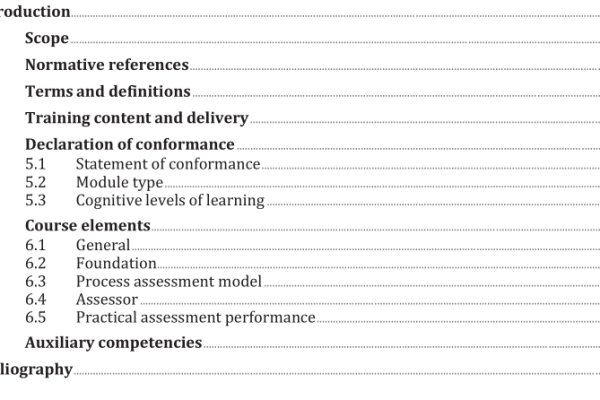ISO IEC TR 33017:2021 pdf download – Information technology — Process assessment — Framework for assessor training.
1 Scope This document provides a framework for assessor training aimed at training providers who design, develop, and/or deliver training courses for assessors conducting assessments conformant with ISO/IEC 33002. The document defines four training course elements: — Foundation — Process assessment model — Assessor — Practical assessment performance Whilst the training is defined as separate training course elements, the elements can be combined into one or more training courses for delivery. Furthermore, training modules and learning objectives can be addressed in training courses in any combination or sequence. 2 Normative references There are no normative references in this document. 3 Terms and definitions No terms and definitions are listed in this document. ISO and IEC maintain terminological databases for use in standardization at the following addresses: — ISO Online browsing platform: available at https://www.iso .org/obp — IEC Electropedia: available at http://www.electropedia .org/ 4 Training content and delivery The following are a set of best practices for the content and delivery of training courses: — Participants receive preparatory information prior to the training event that includes a complete course outline, course schedule and an overview of the learning goals. Participants also receive background reading or work needed to prepare for the training accompanied by instructions. — Training courses are built around a syllabus with content geared toward a particular target group. The level and prior experiences of participants is considered in designing the course. — Training modules and materials include learning objectives with reference to the cognitive levels of learning. — Training materials provided to participants include a set of presentation notes with support materials for each session (e.g. PowerPoint, participant worksheets, and handouts).
— Training includes diverse ways of presenting the material and involving the participants. The materials are designed to include a variety of learning methods including discussions in both small and large groups, interactive exercises, case studies, and role plays providing opportunities for participants to clarify, question, apply, and consolidate new knowledge. The facilitators encourage group participation and are comfortable in modifying activities as needed. — Case study or other experiential methods are supported and facilitated by discussion which give participants the opportunity to seek information beyond what is contained in the case study, and to raise and debate various points of view on the case issues. Participants are encouraged to defend their opinions with evidence and reason. The discussion permits the Instructor to check participant skills in inquiry, analysis, and decision making. — Participants will come to the training event with their own experiences and concerns. Those experiences can be valuable for discussion and application. Using participant experiences will help them see how what they are learning can be carried back into their work. Case studies and specific examples can increase involvement and learning. — Training includes a mechanism for soliciting participant course evaluations and for recording, analysing, and acting on participant feedback received. Such assessment mechanisms may include both daily and end-of-course assessments to provide evidence that the course offers an appropriate “learning opportunity” for participants. Participants are provided with an evaluation form to complete at the end of the training event. 5 Declaration of conformance 5.1 Statement of conformance Any training course wishing to claim conformance to the minimum set (or a subset) of the competencies to be met by the assessor in conducting an assessment conformant with ISO/IEC 33002 as defined in this document may provide a statement of conformance.
ISO IEC TR 33017:2021 pdf download – Information technology — Process assessment — Framework for assessor training






